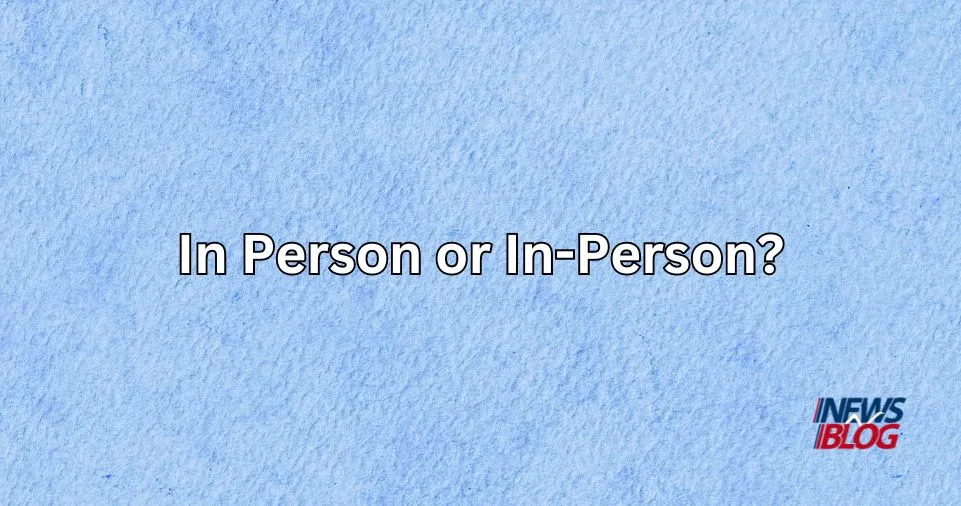Welcome to the world of language nuances! Have you ever wondered whether it’s “in person” or “in-person”?
These two variations might seem interchangeable, but a tiny hyphen can make a big difference.
In this short guide, we’ll unravel the mystery and explore when to use each form. So, let’s dive into the fascinating realm of “in person” and “in-person” to ensure you’re crystal clear on their proper usage.
When to use “In Person”?
“In Person” signifies physical presence, the act of being physically near or with someone.
This compound is often employed when describing face-to-face interactions, emphasizing the tangible proximity of individuals.
It modifies verbs, adjectives, or other adverbs, providing additional information about how an action is carried out.
Example:
“She prefers to communicate in person.”
Here, “in person” serves as an adverb, elucidating the preferred mode of communication.
Example:
“Mark preferred to deliver the news in person, ensuring a genuine connection with his team.”
In this phrase, “in person” conveys how Mark chose to communicate important information.
Where to use “In Person”?
Use “In Person” when referring to direct, physical interactions between individuals.
Example:
“The team chose to discuss the sensitive matter in person to ensure clear communication and understanding.”
Opt for “In Person” when emphasizing the emotional depth and authenticity that comes with being physically present.
Example:
“Emily wanted to apologize to her friend in person, understanding the impact of a heartfelt, face-to-face apology.”
When to use In-Person?
On the flip side, “In-Person” is a compound adjective commonly used to modify nouns, such as meetings, events, or experiences.
“In-person” is a compound word formed by combining “in” and “person” with a hyphen. It denotes activities or situations that occur in a physical, rather than virtual, space.
Example: “The company decided to shift from virtual to in-person training sessions to enhance employee engagement and foster a sense of community.”
In this example, “in-person” is used to describe the nature of training sessions, emphasizing the transition from virtual to physical, with the goal of creating a more engaging and communal learning experience.
Where to use “In-Person”?
Use “In-Person” when modifying nouns to convey that an activity or event requires physical presence.
Example: “The workshop was designed for an in-person audience, with hands-on activities and group discussions.”
Employ “In-Person” when describing events, meetings, or experiences to clarify the physical nature of the gathering.
Example: “The company announced an in-person retreat for team building and collaboration.”
Scenario Examples
Professional Settings
In a professional setting, the distinction is crucial. Consider a scenario where a manager communicates an important policy update:
Incorrect: “The manager announced the changes in-person.”
Here, without the space between “in” and “person,” it appears as if the announcement happened while the manager was physically inside someone.
To convey the intended meaning of a face-to-face announcement, the correct usage would be:
Correct: “The manager announced the changes in person.”
Event Planning
When organizing events, clarity is key. Imagine a conference organizer communicating details about registration:
Incorrect: “Participants are required to register for the conference in person to receive their badges.”
To avoid confusion and ensure participants understand the necessity of physical presence, the correct expression would be:
Correct: “Participants are required to register for the conference in-person to receive their badges.”
Personal Interactions
In personal interactions, choosing the appropriate term can impact the emotional tone. Picture a heartfelt apology:
Incorrect: “Lisa wanted to apologize to her friend inperson for the misunderstanding.”
To convey the sincerity of a face-to-face apology, the correct choice would be:
Correct: “Lisa wanted to apologize to her friend in person for the misunderstanding.”
Navigating Grammar and Style
Grammar Rules
Understanding the grammatical nuances of these compound expressions is essential for clear communication.
In the case of “In Person,” the two words function independently, with “in” acting as a preposition and “person” as the object. This construction aligns with standard grammatical rules.
On the other hand, “In-Person” is an example of a compound adjective.
The hyphen between “in” and “person” serves to connect the words, creating a single, cohesive modifier for the noun it precedes.
Stylistic Considerations
From a stylistic perspective, the choice between the two forms can impact the flow and readability of your writing.
- “In Person” tends to lend a more formal tone, suitable for professional communications.
- “In-Person” can add a modern and streamlined touch, often seen in event invitations or casual settings.
Conclusion
In the symphony of language, the distinction between “in person” and “in-person” may seem subtle, but it can create harmony or discord in your communication.
Whether you’re planning a family gathering or orchestrating a professional event, choosing the right phrase ensures your message hits the right note.
Remember, “in person” emphasizes personal presence, adding warmth to invitations, while “in-person” signals a physical requirement, adding a touch of formality.
So, as you navigate the linguistic landscape, let these nuances guide your choice, creating a seamless melody of clarity and expression in your interactions.
Also Read:

